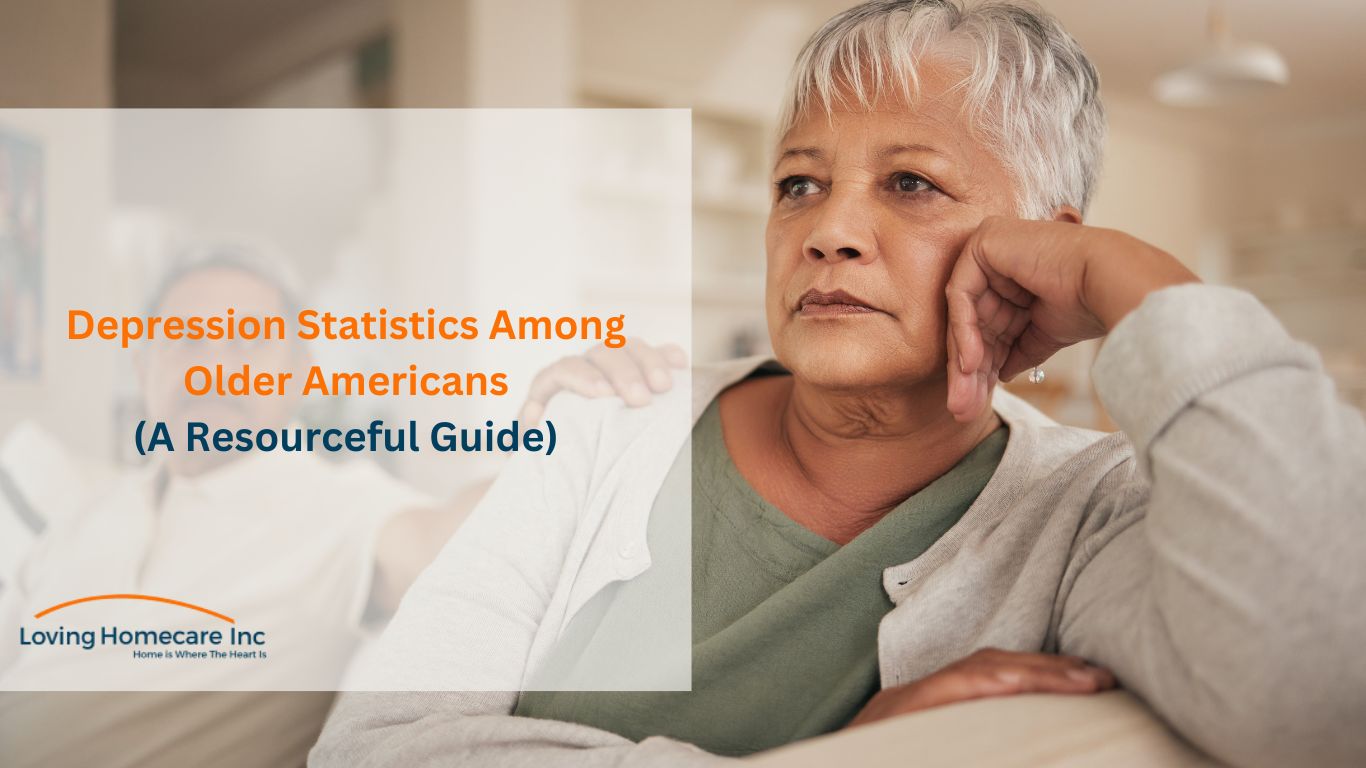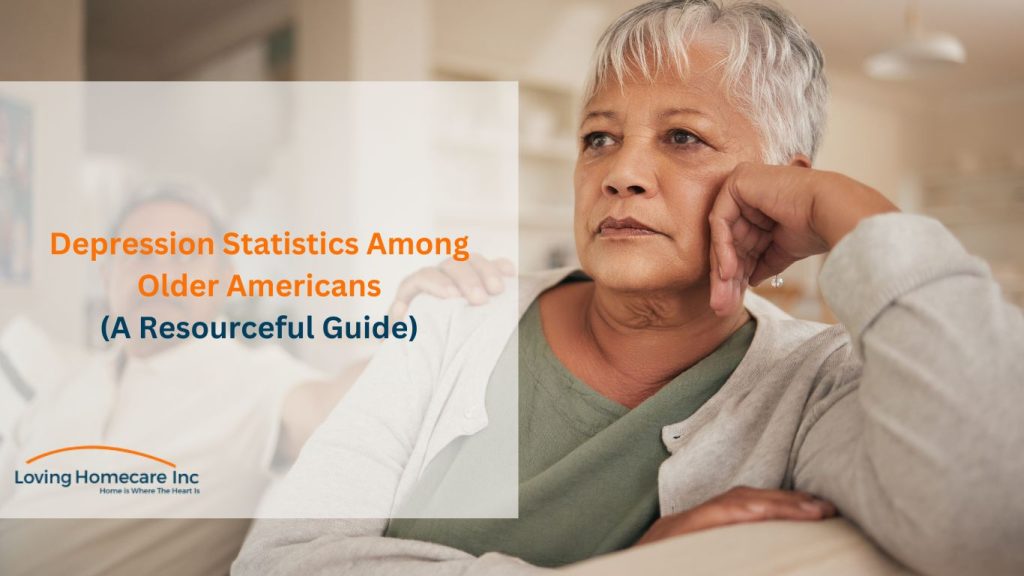Recently updated on December 12th, 2024 at 04:52 am

Depression in older adults is a critical yet often overlooked public health issue in the United States. Affecting approximately 20% of those aged 65 and over, it represents not just a substantial portion of this demographic but also a call to action for enhanced mental health care and awareness.
This article aims to navigate through the intricate seniors and depression statistics, shedding light on the often-hidden struggles they face. We will delve into the scientific foundations of mental illness in seniors, exploring how age-related changes in the brain, lifestyle, and social factors converge to impact mental health.
Additionally, we will examine older adults and depression statistics, and various treatment options available, highlighting encouraging data on recovery rates. This exploration is not just about numbers; it’s a journey to understand and address the mental health challenges faced by our aging population.
The Statistical Reality of Depression in Older Adults

Prevalence and Demographics
Depression is a significant concern for the aging population in the United States, with about 20% of adults aged 65 and over experiencing some form of this mental health condition. This statistic is not just a number; it represents millions of lives impacted by the emotional and physical challenges that depression brings.
Interestingly, gender plays a role in the prevalence of depression among seniors. Women, in their senior years, are more likely to experience depression compared to their male counterparts. This disparity could be attributed to a combination of biological factors, life experiences, and social pressures that women face throughout their lives.
Moreover, while 20% is a striking figure, it’s crucial to note that about 5% of older adults living in the community are affected by major depression. This form of depression is more severe and debilitating, often requiring more intensive treatment and support.
Risk Factors
Understanding the risk factors for depression in older adults is key to addressing this public health issue. A staggering 80% of older adults have at least one chronic health condition, and 50% have two or more. These chronic conditions, such as heart disease, diabetes, or arthritis, not only pose physical challenges but also contribute significantly to the development of depression due to the stress and limitations they bring.
Another critical factor is bereavement. Up to 25% of seniors experience depressive symptoms following the loss of a loved one. This high percentage underscores the profound impact that loss and grief can have on the mental health of older adults.
Strategies to Address Depression in Older Adults
| Strategy | Description |
|---|---|
| Regular Health Screenings | Early identification of depression through routine screenings during regular health check-ups. |
| Social Support Systems | Encouraging participation in community groups or activities to reduce isolation and loneliness. |
| Mental Health Education | Educating seniors and caregivers about the signs of depression and available treatments. |
| Access to Mental Health Services | Providing easier access to mental health professionals and counseling services. |
| Physical Activity Programs | Promoting regular exercise to improve mood and overall well-being. |
| Chronic Disease Management | Offering support for managing chronic conditions to reduce the associated stress and depressive symptoms. |
| Bereavement Support | Providing grief counseling and support groups for those dealing with loss. |
Recovery and Growth: A Look at the Positive Side

While the prevalence of depression among older adults is a significant concern, the journey toward recovery and mental health improvement offers a beacon of hope. The resilience of the human spirit, coupled with effective treatment strategies and elderly home care, paints a promising picture for seniors battling depression.
Encouraging Recovery Rates
A substantial number of older adults show a positive response to depression treatment. Studies indicate that about 60-70% of seniors experience significant improvement when they receive appropriate treatment for their depressive symptoms. This high response rate is a testament to the effectiveness of current treatment methodologies and the adaptability of older individuals to therapeutic interventions.
The Role of Cognitive-Behavioral Therapy (CBT)
Cognitive-behavioral therapy (CBT) stands out as a particularly effective treatment for depression in the elderly. With a success rate of approximately 58%, CBT addresses the negative thought patterns and behaviors that often contribute to depression. It empowers seniors to challenge and change their thought processes, leading to improved mood and coping skills. This approach is especially beneficial as it is tailored to the individual, taking into account the unique challenges and experiences of older adults.
Treatment Success Rates in Older Adults
| Treatment Method | Success Rate | Description |
|---|---|---|
| General Treatment for Depression | 60-70% | Includes medication, psychotherapy, lifestyle changes, and support systems. |
| Cognitive-behavioral therapy (CBT) | 58% | A form of psychotherapy that helps in changing negative thought patterns and behaviors. |
The Importance of Holistic Approaches
The journey to recovery from depression in older adults often requires a holistic approach. This includes not only medical treatments and psychotherapy but also lifestyle modifications, social support, and activities that promote mental and physical well-being. Engaging in regular physical activity, maintaining a healthy diet, and participating in social activities can significantly enhance the effectiveness of traditional treatments.
Understanding Depression in Older Adults in the USA

Depression affects approximately 20% of adults aged 65 and over in the United States, a significant figure that underscores the need for better mental health care in this demographic. This condition is more prevalent in women and about 5% of older adults living in the community show signs of major depression. Key risk factors include chronic diseases, with 80% of older adults having at least one chronic health condition, and bereavement, affecting up to 25% of seniors.
Recovery and Treatment
Despite these challenges, the recovery rates are promising. About 60-70% of older adults respond positively to depression treatment, with cognitive-behavioral therapy (CBT) showing a success rate of around 58%. Treatment success hinges on a combination of medication, psychotherapy, lifestyle changes, and support systems.
Scientific Reasons Behind Mental Illness in Seniors
Several factors contribute to depression in seniors:
- Neurological Changes: Brain imaging studies reveal structural and functional changes in the prefrontal cortex and hippocampus in depressed seniors, with up to 40% showing hippocampal atrophy.
- Biochemical Factors: Alterations in neurotransmitters like serotonin, which can be up to 30% lower in depressed individuals over 60, play a significant role.
- Genetic Predisposition: The risk increases by up to 40% if there’s a family history of depression.
Types of Treatment: Tailoring to the Needs of Seniors

Medication
Medication plays a pivotal role in treating depression in older adults, though it comes with certain challenges. Approximately 30-40% of seniors do not respond to the first antidepressant prescribed. This necessitates a careful and often trial-and-error approach to find the most effective medication with the least side effects.
- Selective Serotonin Reuptake Inhibitors (SSRIs): These are often the first line of treatment due to their relative safety and lower risk of side effects compared to older antidepressants. SSRIs work by increasing the level of serotonin in the brain, a neurotransmitter associated with mood regulation. Despite their effectiveness, healthcare providers must monitor seniors closely due to potential interactions with other medications commonly used in this age group.
Psychotherapy
Psychotherapy offers a non-pharmacological approach to treating depression, with Cognitive-Behavioral Therapy (CBT) being particularly effective. About 58% of seniors with depression show improvement with CBT. This form of therapy focuses on identifying and changing negative thought patterns and behaviors, which can be particularly beneficial for seniors who may be dealing with life transitions and loss.
- Group Therapy: Another promising aspect of psychotherapy is group therapy, where participation in group sessions can enhance the effectiveness of other treatments. It provides social support, reduces feelings of isolation, and allows seniors to learn coping strategies from peers facing similar challenges.
Lifestyle and Alternative Treatments
Incorporating lifestyle changes and alternative treatments can significantly augment traditional treatment methods.
- Physical Activity: Engaging in regular physical activity is known to reduce depressive symptoms by up to 30%. Exercise releases endorphins, often referred to as ‘feel-good’ hormones, and promotes overall physical health, which is intrinsically linked to mental health.
- Mindfulness and Meditation: These practices have shown a 20% improvement in mood symptoms among seniors. Mindfulness and meditation can help reduce stress, improve concentration, and promote a sense of peace, which are all beneficial for managing depression.
FAQs:
Final Thoughts:
The path to overcoming depression in older adults is paved with challenges, but the high rates of recovery and the effectiveness of treatments like CBT offer hope and optimism. By continuing to focus on holistic and tailored treatment plans, we can further improve the mental health and quality of life for seniors.
Are you looking for compassionate and specialized care for your elderly loved ones? Consider Loving Homecare’s senior care services. Our dedicated team provides the right support and care, ensuring your loved ones receive the attention and treatment they deserve in the comfort of their own home.

